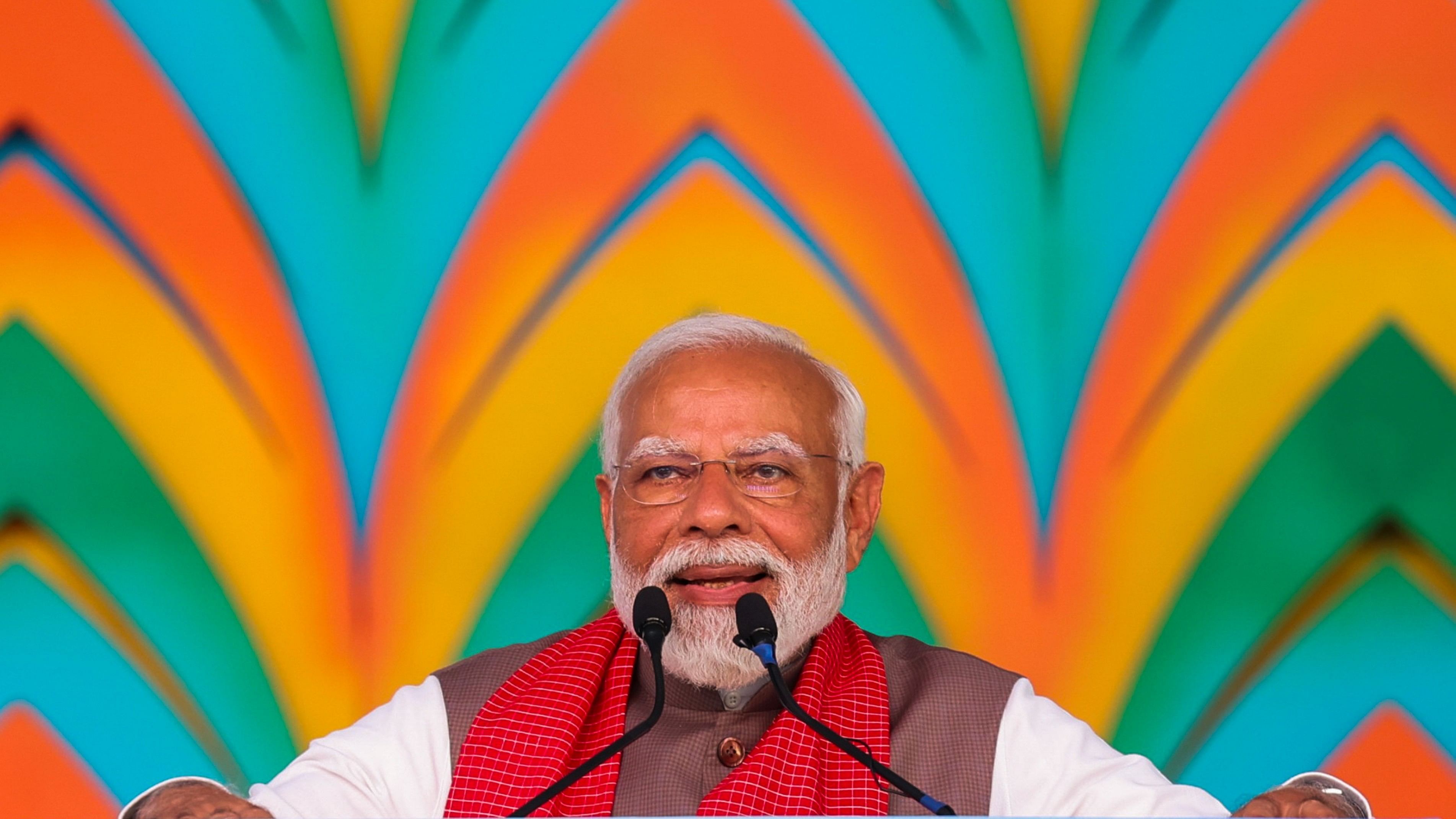
A file photo of Prime Minister Narendra Modi.
Credit: PTI File Photo
By Andy Mukherjee
As India’s six-week-long general election grinds past the halfway mark, Prime Minister Narendra Modi’s messaging has shifted from confident to shrill. After the first couple of phases of polling showed a 3-percentage-point drop in turnout, both Modi and his party leaders have largely stopped promoting their accomplishments of the past 10 years, or, for that matter, the “Modi guarantees” offered in the Bharatiya Janata Party’s manifesto for the next five.
Instead, making the majority Hindu population fear and loathe Muslims seems to be the BJP’s preferred talking point. Modi went on the offensive in an April 21 speech where he suggested that Rahul Gandhi’s Congress Party, if elected, would “calculate the gold with mothers and sisters,” and redistribute it “among those who have more children... among infiltrators,” tropes that his supporters routinely use to refer to Muslims, the largest religious minority.
The third of seven rounds ended Tuesday amid a deadly heat wave that is gripping much of South Asia and keeping voters from queuing up to cast their ballots. The Election Commission, which is meant to ensure that campaign publicity doesn’t end up accentuating communal fault lines, would have sanctioned any other political figure for the kind of comments that the prime minister is making. But the watchdog is so reluctant to take on Modi, it sent a code-of-conduct violation notice to his party chief.
A record turnout in 2019 had helped Modi’s BJP tremendously, and the party was hoping that its star campaigner’s popularity —and his consecration of a Hindu temple at a disputed site earlier this year — would lead to a repeat. That doesn’t seem to be happening, and people have already voted (or chosen not to) for a little more than half of the 543 parliamentary seats that have gone to the polls. While the BJP is still the pollsters’ favorite to win, the party and its leaders appear to be oddly nervous, and are ramping up the fear-mongering accordingly. “If you have two buffaloes, the Congress will take one,” Modi said at a rally in Gujarat, his home state.
The Congress Party hasn’t said anything about wealth redistribution. It has, however, promised an expansion of affirmative action. This is where the BJP sees an opportunity to pit Muslims against other disenfranchised groups. “If you are a non-Muslim,” says a now-deleted video, posted under the party’s Instagram handle, “Congress will snatch your wealth and distribute it to Muslims. Narendra Modi knows of this evil plan. Only he has the strength to stop it.”
Next came a 17-second cartoon clip, in which Gandhi is shown hatching just such a plan of favoring Muslims at the expense of marginalized Hindu groups. But is that what Gandhi is really proposing? Muslims can’t anyway be given religion-based reservation in higher education and government jobs. To do so would run afoul of India’s secular constitution. What the main opposition grouping has vowed in its manifesto is that it will increase the overall 50% limit on affirmative action, after first doing a caste census.
The last such exercise, which divided the population into roughly 4,000 groups and sub-groups, was under British rule in 1931. After independence in 1947, the government gave itself constitutional powers to make special provisions for the advancement of any deprived classes, castes and tribes. India’s affirmative action program, which predates the US Civil Rights Act of 1964, began with the most marginalized castes, often referred to as Dalits (broken people) and Adivasis (aboriginals). They are counted every 10 years, but other underprivileged groups are not. The caste data from a 2011 socioeconomic survey wasn’t made public.
To refuse to gauge the extent of a malaise won’t make it go away. Although the over-representation of disadvantaged castes in certain industries such as leather and waste handling has reduced sharply, it hasn’t ended even after eight decades of affirmative action.
In the 1980s, more than 80 per cent of casual-wage workers’ sons were also in irregular employment. That figure has come down to 53% for higher castes, but is still stuck at 76 per cent for Dalits, according to last year’s State of Working India report by the Azim Premji University in Bengaluru. Female participation in the economy is abysmal: Every second young woman is neither working, nor studying. Separate data shows that when it comes to education, India’s Muslim youths are faring worse than Dalits.
Can some Muslim communities be given quotas, not because of their religion but because of their socioeconomic deprivation? Creating any new entitlement won’t be politically easy. When I was at Delhi University in 1990, massive protests broke out over a 27 per cent quota in federal jobs for so-called other backward classes. The policy survived, though not the government that had introduced it.
Muslims in Karnataka and Kerala are already eligible for state-level quotas. Tamil Nadu offers them to 95 per cent of Muslim communities. Andhra Pradesh, too, reserves jobs and educational seats for some Islamic sects. These states happen to be in the country’s more prosperous south. It’s time to begin a mature conversation on how to create more opportunities for Muslims in a rapidly modernizing economy. Demonizing them, as the BJP is doing with its animated videos, is hardly a way to go about such a dialogue.
Even as a pliant Election Commission looks the other way, Modi must weigh the consequences of his dog whistles. The Indian prime minister’s desperation for a third term is putting a target on the back of a vulnerable minority — and placing millions of lives at risk.